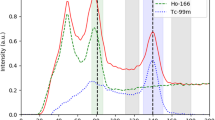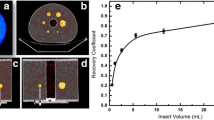Abstract
Purpose
90Y-labelled compounds used in targeted radiotherapy are usually imaged with SPECT by recording the bremsstrahlung X-rays of the β decay. The continuous shape of the X-ray spectrum induces the presence of a significant fraction of scatter rays in the acquisition energy window, reducing the accuracy of biodistribution and of dosimetry assessments.
Methods
The aim of this paper is to use instead the low branch of e− e+ pair production in the 90Y decay. After administration of 90Y-labelled SIR-Spheres by catheterization of both liver lobes, the activity distribution is obtained by 90Y time-of-flight (TOF) PET imaging. The activity distribution is convolved with a dose irradiation kernel in order to derive the regional dosimetry distribution.
Results
Evaluation on an anatomical phantom showed that the method provided an accurate dosimetry assessment. Preliminary results on a patient demonstrated a high-resolution absorbed dose distribution with a clear correlation with tumour response.
Conclusion
This supports the implementation of 90Y PET in selective internal radiation therapy of the liver.




Similar content being viewed by others
References
Brans B, Linden O, Giammarile F, Tennvall J, Punt C. Clinical applications of newer radionuclide therapies. Eur J Cancer 2006;42(8):994–1003.
de Jong M, Breeman WA, Valkema R, Bernard BF, Krenning EP. Combination radionuclide therapy using 177Lu- and 90Y-labeled somatostatin analogs. J Nucl Med 2005;46:13S–7.
Flux G, Bardies M, Monsieurs M, Savolainen S, Strand SE, Lassmann M et al. The impact of PET and SPECT on dosimetry for targeted radionuclide therapy. Z Med Phys 2006;16:47–59.
Flux G, Bardies M, Chiesa C, Monsieurs M, Savolainen S, Strand SE, et al. Clinical radionuclide therapy dosimetry: the quest for the “Holy Gray”. Eur J Nucl Med Mol Imaging 2007;34(10):1699–700.
Brans B, Bodei L, Giammarile F, Linden O, Luster M, Oyen WJ, et al. Clinical radionuclide therapy dosimetry: the quest for the “Holy Gray”. Eur J Nucl Med Mol Imaging 2007;34(5):772–86.
Sgouros G, Frey E, Wahl R, He B, Prideaux A, Hobbs R. Three-dimensional imaging-based radiobiological dosimetry. Semin Nucl Med 2008;38(5):321–34.
Stabin MG, Brill AB. State of the art in nuclear medicine dose assessment. Semin Nucl Med 2008;38(5):308–20.
Mansberg R, Sorensen N, Mansberg V, Van der Wall H. Yttrium 90 Bremsstrahlung SPECT/CT scan demonstrating areas of tracer/tumour uptake. Eur J Nucl Med Mol Imaging 2007;34(11):1887.
Shen S, DeNardo GL, DeNardo SJ. Quantitative bremsstrahlung imaging of yttrium-90 using a Wiener filter. Med Phys 1994;21(9):1409–17.
Minarik D, Sjögreen Gleisner K, Ljungberg M. Evaluation of quantitative (90)Y SPECT based on experimental phantom studies. Phys Med Biol 2008;53(20):5689–703.
Sgouros G. Yttrium-90 biodistribution by yttrium-87 imaging: a theoretical feasibility analysis. Med Phys 1998;25(8):1487–90.
Pauwels S, Barone R, Walrand S, Borson-Chazot F, Valkema R, Kvols LK, et al. Practical dosimetry of peptide receptor radionuclide therapy with (90)Y-labeled somatostatin analogs. J Nucl Med 2005;46(1):92S–8.
Barone R, Borson-Chazot F, Valkema R, Walrand S, Chauvin F, Gogou L, et al. Patient-specific dosimetry in predicting renal toxicity with (90)Y-DOTATOC: relevance of kidney volume and dose rate in finding a dose-effect relationship. J Nucl Med 2005;46(1):99S–106.
Walrand S, Jamar F, Mathieu I, De Camps J, Lonneux M, Sibomana M, et al. Quantitation in PET using isotopes emitting prompt single gammas: application to yttrium-86. Eur J Nucl Med Mol Imaging 2003;30(3):354–61.
Beattie BJ, Finn RD, Rowland DJ, Pentlow KS. Quantitative imaging of bromine-76 and yttrium-86 with PET: a method for removal of spurious activity introduced by cascade gamma rays. Med Phys 2003;30(9):2410–23.
Buchholz HG, Herzog H, Förster GJ, Reber H, Nickel O, Rösch F, et al. PET imaging with yttrium-86: comparison of phantom measurements acquired with different PET scanners before and after applying background subtraction. Eur J Nucl Med Mol Imaging 2003;30(5):716–20.
Kull T, Ruckgaber J, Weller R, Reske S, Glatting G. Quantitative imaging of yttrium-86 PET with the ECAT EXACT HR+ in 2D mode. Cancer Biother Radiopharm 2004;19(4):482–90.
Reubi JC, Schär JC, Waser B, Wenger S, Heppeler A, Schmitt JS, et al. Affinity profiles for human somatostatin receptor subtypes SST1-SST5 of somatostatin radiotracers selected for scintigraphic and radiotherapeutic use. Eur J Nucl Med 2000;27:273–82.
de Jong M, Bakker WH, Krenning EP, Breeman WAP, van der Pluijm ME, Bernard BF, et al. Yttrium-90 and indium-111 labelling, receptor binding and biodistribution of [DOTA0,d-Phe1, Tyr3]octreotide, a promising somatostatin analogue for radionuclide therapy. Eur J Nucl Med 1997;24:368–71.
Cremonesi M, Ferrari M, Bodei L, Tosi G, Paganelli G. Dosimetry in peptide radionuclide receptor therapy: a review. J Nucl Med 2006;47(9):1467–75.
Wessels BW, Konijnenberg MW, Dale RG, Breitz HB, Cremonesi M, Meredith RF, et al. MIRD pamphlet No. 20: the effect of model assumptions on kidney dosimetry and response—implications for radionuclide therapy. J Nucl Med 2008;49:1884–99.
Quadri SM, Shao Y, Blum JE, Leichner PK, Williams JR, Vriesendorp HM. Preclinical evaluation of intravenously administered 111In- labeled and 90Y-labeled B72.3 immunoconjugate (GYK-DTPA) in beagle dogs. Nucl Med Biol 1993;20(5):559–70.
Carrasquillo JA, White JD, Paik CH, Raubitschek A, Le N, Rotman M, et al. Similarities and differences in 111In- and 90Y-labeled 1B4M-DTPA antiTac monoclonal antibody distribution. J Nucl Med 1999;40(2):268–76.
Ford K. Predicted 0+ level of Zr90. Phys Rev 1955;98:1516.
Nickles RJ, Roberts AD, Nye JA, Converse AK, Barnhart TE, Avila-Rodriguez MA, et al. Assaying and PET imaging of yttrium-90: 1>>34 ppm>0. IEEE Nucl Sci Symp Conf Rec 2004;6:3412–4.
Selwyn RG, Nickles RJ, Thomadsen BR, DeWerd LA, Micka JA. A new internal pair production branching ratio of 90Y: the development of a non-destructive assay for 90Y and 90Sr. Appl Radiat Isot 2007;65:318–27.
Langhoff H, Hennies H. Zum experimentellen Nachweis von Zweiquantenzerfall beim 0+-0+-Übergang des Zr90. Z Phys 1961;164:166–73.
Lhommel R, Goffette P, Van den Eynde M, Jamar F, Pauwels S, Bilbao JI, et al. Yttrium-90 TOF PET scan demonstrates high-resolution biodistribution after liver SIRT. Eur J Nucl Med Mol Imaging 2009;36:1696. doi:10.1007/s00259-009-1210-1.
Gulec SA, Siegel JA. Posttherapy radiation safety considerations in radiomicrosphere treatment with 90Y-microspheres. J Nucl Med 2007;48(12):2080–6.
Campbell JM, Wong CO, Muzik O, Marples B, Joiner M, Burmeister J. Early dose response to yttrium-90 microsphere treatment of metastatic liver cancer by a patient-specific method using single photon emission computed tomography and positron emission tomography. Int J Radiat Oncol Biol Phys 2009;74(1):313–20.
Bilbao JI, Reiser MF, editors. Liver radioembolization with 90Y microspheres (medical radiology/diagnostic imaging). Berlin: Springer; 2008. p. 86.
Surti S, Kuhn A, Werner ME, Perkins AE, Kolthammer J, Karp JS. Performance of Philips Gemini TF PET/CT scanner with special consideration for its time-of-flight imaging capabilities. J Nucl Med 2007;48:471–80.
Wang W, Hu Z, Gualtieri EE, Parma MJ, Walsh ES, Sebok D, et al. Systematic and distributed time-of-flight list mode PET reconstruction. IEEE Nucl Sci Symp Conf Rec 2006;3:1715–22.
Daube-Witherspoon ME, Matej S, Karp JS, Lewitt RM. Application of the row action maximum likelihood algorithm with spherical basis functions to clinical PET imaging. IEEE Trans Nucl Sci 2001;48(1):24–30.
Cross WG, Freedman NO, Wong PY. Tables of beta-ray dose distributions in water. Ontario: Atomic Energy of Canada, Ltd, Report No AECL-10521; 1992. http://inisdb2.iaea.org/inis/php/download.php?s=p&rn=23047981.
Franquiz JM, Chigurupati S, Kandagatla K. Beta voxel S values for internal emitter dosimetry. Med Phys 2003;30(6):1030–2.
Bolch WE, Bouchet LG, Robertson JS, Wessels BW, Siegel JA, Howell RW, et al. MIRD Pamphlet No. 17: the dosimetry of nonuniform activity distributions—radionuclide S values at the voxel level. Medical Internal Radiation Dose Committee. J Nucl Med 1999;40:11S–36.
Vardi Y, Lee D. From image deblurring to optimal investments: maximum likelihood solutions for positive linear inverse problems. J R Stat Soc Series B Stat Methodol 1993;55(3):569–612.
Phelps ME, editor. PET: physics, instrumentation, and scanners. New York: Springer; 2006.
Kennedy A, Nag S, Salem R, Murthy R, McEwan AJ, Nutting C, et al. Recommendations for radioembolization of hepatic malignancies using yttrium-90 microsphere brachytherapy: a consensus panel report from the radioembolization brachytherapy oncology consortium. Int J Radiat Oncol Biol Phys 2007;68(1):13–23.
US Nuclear Regulatory Commission. 2007–10: yttrium-90 theraspheres and sirspheres impurities. Washington, DC: US Nuclear Regulatory Commission; 2007. NRC Information Notice.
Stabin M, Konijnenberg M. Re-evaluation of absorbed fractions for photons and electrons in spheres of various sizes. J Nucl Med 2000;41(1):149–60.
Stabin MG, Sparks RB, Crowe E. OLINDA/EXM: the second-generation personal computer software for internal dose assessment in nuclear medicine. J Nucl Med 2005;46:1023–7.
Moszynski M. NATO security through science series: radiation detectors for medical applications. Dordrecht: Springer; 2006. p. 293–315.
Pepin CM, Berard P, Perrot AL, Pepin C, Houde D, Lecomte R, et al. Properties of LYSO and recent LSO scintillators for phoswich PET detectors. IEEE Trans Nucl Sci 2004;51(3):789–95.
Pidol L, Kahn-Harari A, Viana B, Virey E, Ferrand B, Dorenbos P, et al. High efficiency of lutetium silicate scintillators, Ce-doped LPS, and LYSO crystals. IEEE Trans Nucl Sci 2004;51(3):1084–7.
Acknowledgments
The authors thank Glenn Flux, Ph.D., for helpful comments.
Conflicts of interest
None.
Author information
Authors and Affiliations
Corresponding author
Rights and permissions
About this article
Cite this article
Lhommel, R., van Elmbt, L., Goffette, P. et al. Feasibility of 90Y TOF PET-based dosimetry in liver metastasis therapy using SIR-Spheres. Eur J Nucl Med Mol Imaging 37, 1654–1662 (2010). https://doi.org/10.1007/s00259-010-1470-9
Received:
Accepted:
Published:
Issue Date:
DOI: https://doi.org/10.1007/s00259-010-1470-9




